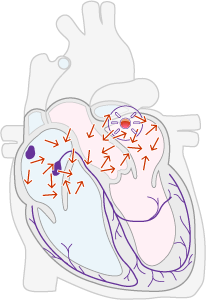Cardiology Teaching Package
A Beginners Guide to Normal Heart Function, Sinus Rhythm & Common Cardiac Arrhythmias
Symptoms and Risks Associated with Atrial Fibrillation
The fibrillation, or quivering, that takes place is due to individual muscle fibres contracting independently due to the chaotic conduction within the atria. (see below)
Image: Disorganised electrical activity within the Atria

Note ectopic focus top right corner of atria.
What does AF look like?
- shortness of breath. The loss of the "atrial kick", with subsequent loss of 30% of the output from the heart, means that organs may suffer from oxygen depletion. When this occurs, messages are sent to the brain saying "we need more oxygen". The brain then instructs the lungs to increase in speed. Therefore, increased respiratory rate is a natural reaction of the body to oxygen depletion. (Involuntary response)
- Chest Pain. The loss of the "atrial kick" also leads to oxygen depletion in the coronary circulation, possibly leading to ischaemic, or angina-type pain.
- Palpitations. Often the first symptom experienced in Atrial Fibrillation. The heart rate increases to 110-140 beats per minute, often higher and the patient often experiences their heart racing.
Chest pain and shortness of breath are not always present in AF but are more likely the faster the rate becomes. This is because normally we may not use more than 70% of the potential output from the heart. So, if the heart is pumping at its normal rate of 55-85 beats per minute, the ventricles have enough time to fill and empty efficiently. Thus ensuring a relatively good output.
Unfortunately, in AF the heart tends to be beating at above 140 bpm and, consequently, the ventricles have far less time to fill and empty. This leads to a much more severe reduction in output from the ventricles (maybe more than 50%) and an increase in symptoms.
Risks
Due to the loss of contract of the atria (the atrial kick), a significant amount of blood starts to slow down or pool in the atria leading to increased risk of clot formation.
If this occurred, complications such as: pulmonary embolism (PE); deep vein thrombosis (DVT); cerebro-vascular accident (CVA/stroke), and myocardial infarction (heart attack/MI) might develop. Therefore, patients in AF are anti-coagulated if the first attempts at cardioversion are unsuccessful.
Cardioversion is the use of drugs or electric shock to change the heart rhythm back to sinus rhythm.
